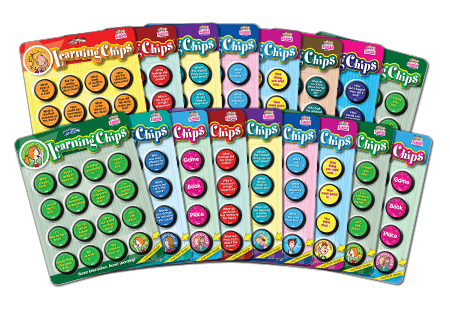
Kagan Learning Chips
- Gets students interacting over any learning topic!
- Creates non-stop, positive discussion.
- Increases understanding and retention.
- Great for whole class activities.
Top Ideas for Using Learning Chips
Learning Chips are chips with terrific prompts designed to get students interacting over just about any curriculum. Use Kagan Structures to maximize student engagement with Learning Chips. Here are the top structures for using Learning Chips.
Team Structures

Draw-A-Chip
Teams stack the chips on the team table, face down. The teacher selects the topic. For example, the topic may be a book the class just read. In this case, the team uses the Story Chips. One teammate starts by drawing the first chip and reading the prompt. “What is the moral of the story?” That student responds to the prompt. The next student draws the next chip and responds to the next prompt.

Choose-A-Chip
Teams spread out the chips on the team table, face up. The teacher provides the topic. For example, the topic may be Martin Luther King, Jr. Students use the Famous Folks Chips to investigate his life and times. One teammate starts by drawing the first chip and reading the prompt. “What did this person believe in?” That student responds to the prompt. When done responding, the student places the chip in a used pile, encouraging students to respond to the other prompts.

Drop-A-Chip
Use with: Celebration Chips
Students are seated in teams. Each student is given a celebration chip or multiple celebration chips with praising words or actions on them (e.g., “Great idea!” or “High Five!”). Students are told they have to use their chips within a specified period. Students drop their chips on teammates as they praise them using words or actions. After students use their own chips, they can use the chips that are dropped on them.
Deal the Chips
Use with: Discussion Chips
In teams, each student is dealt the same number of chips (usually 2–4) chips. The teacher provides an open-ended discussion topic. For example, “Should students be required to wear school uniform?” One student begins the discussion. Any student may go next, using his/her chip’s prompt to add to the discussion. For example, the student with the chip, “I respectfully disagree. I think…” can use his/her chip to offer a counter argument. The used chips are placed down in front the student. All students must use their chips during the discussion. Once everyone has used their chips, they re-deal the chips and continue the discussion.

Paraphrase Passport
Use with: Paraphrase Chips
Use Choose-a-Chip with the Paraphrase Chips to play Paraphrase Passport. Here’s how: The chips are spread out on the team table, face up. The teacher gives the class a discussion topic. For example, “Should there be restrictions on what can be put on the Internet?” One teammate begins the discussion. Any teammate must go next, but first he/she must select a paraphrase chip to paraphrase the prior speaker before he/she has the “passport” to speak. For example, the student may use the chip “I heard you say…” to paraphrase a teammate. Students place their used chips in front of them, so the team and the teacher can see who’s contributed and who still needs to contribute to the discussion.
Single RoundRobin
The team has a set of chips face down on their team table. The teacher selects a topic. For this example, let’s use the Teambuilding Chips set. One teammate draws a chip and reads the prompt, “What do you do for fun?” That teammate responds. Then each teammate takes a turn responding to the same prompt. The next teammate turns over the next chip and the process continues until time’s up.

AllRecord RoundRobin
AllRecord RoundRobin adds a writing component to RoundRobin. Students pause after each teammate shares to record in their own words, on their own paper, the ideas they heard from teammates.
Pick A Teammate
Pick A Teammate is alternative for many of the ideas above. Instead of answering the prompt themselves, students read the prompt, then pick a teammate they want to hear respond. This is fun with the Teambuilding and Classbuilding Chips.
Pair Structures

Timed Pair Share
Students each select a chip, then pair up. In pairs, students take turns sharing their response to the chip for a predetermined time.
RallyRobin
The chips are spread out face down in front of a pair. Partner A draws the first chip and responds. Partner B draws the next chip and responds. The pair continues alternating turns until all chips are drawn.
Whole Class Structures

Quiz-Quiz-Trade
Each student in the class gets one chip. They stand up, put a hand up, and pair up with one other student with his/her hand up. Partner A reads his/her chip’s prompt to Partner B. For example, if they have the Classbuilding Chips, the question may be, “What is your favorite color? Why?” Partner B responds. Then Partner B reads his/her chip’s prompt to Partner A. Partner A responds. Students trade chips, then put up their hands and find a new partner with a hand up.
Inside-Outside Circle
Give each student in the class one chip. Students form pairs. One student from each pair forms a large circle in the class. Then the remaining students find their partners to form an inside circle. The outside circle students read their chips and the inside circle students respond. Then the inside circle students read their chips and the outside circle students respond. They trade chips and the teacher tells the class to rotate, “Inside circle, please rotate clockwise three partners." Students pair up with new partners to discuss the chips they’re holding.

